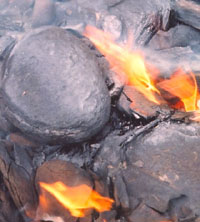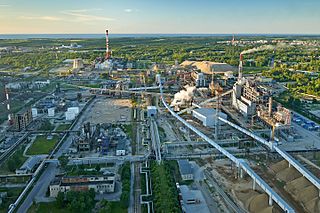Related Research Articles

Oil shale is an organic-rich fine-grained sedimentary rock containing kerogen from which liquid hydrocarbons can be produced, called shale oil. Shale oil is a substitute for conventional crude oil; however, extracting shale oil is costlier than the production of conventional crude oil both financially and in terms of its environmental impact. Deposits of oil shale occur around the world, including major deposits in the United States. A 2016 estimate of global deposits set the total world resources of oil shale equivalent of 6.05 trillion barrels of oil in place.
Shale oil is an unconventional oil produced from oil shale rock fragments by pyrolysis, hydrogenation, or thermal dissolution. These processes convert the organic matter within the rock (kerogen) into synthetic oil and gas. The resulting oil can be used immediately as a fuel or upgraded to meet refinery feedstock specifications by adding hydrogen and removing impurities such as sulfur and nitrogen. The refined products can be used for the same purposes as those derived from crude oil.
Petrosix is the world’s largest surface oil shale pyrolysis retort with an 11 metres (36 ft) diameter vertical shaft kiln, operational since 1992. It is located in São Mateus do Sul, Brazil, and it is owned and operated by the Brazil energy company Petrobras. Petrosix means also the Petrosix process, an externally generated hot gas technology of shale oil extraction. The technology is tailored to Irati oil shale formation, a Permian formation of the Paraná Basin.

The oil shale industry is an industry of mining and processing of oil shale—a fine-grained sedimentary rock, containing significant amounts of kerogen, from which liquid hydrocarbons can be manufactured. The industry has developed in Brazil, China, Estonia and to some extent in Germany and Russia. Several other countries are currently conducting research on their oil shale reserves and production methods to improve efficiency and recovery. Estonia accounted for about 70% of the world's oil shale production in a study published in 2005.

Shale oil extraction is an industrial process for unconventional oil production. This process converts kerogen in oil shale into shale oil by pyrolysis, hydrogenation, or thermal dissolution. The resultant shale oil is used as fuel oil or upgraded to meet refinery feedstock specifications by adding hydrogen and removing sulfur and nitrogen impurities.

The history of the oil shale industry started in ancient times. The modern industrial use of oil shale for oil extraction dates to the mid-19th century and started growing just before World War I because of the mass production of automobiles and trucks and the supposed shortage of gasoline for transportation needs. Between the World Wars oil shale projects were begun in several countries.
Oil shale in China is an important source of unconventional oil. A total Chinese oil shale resource amounts of 720 billion tonnes, located in 80 deposits of 47 oil shale basins. This is equal to 48 billion tonnes of shale oil. At the same time there are speculations that the actual resource may even exceed the oil shale resource of the United States.
The Kiviter process is an above ground retorting technology for shale oil extraction.
The TOSCO II process is an above ground retorting technology for shale oil extraction, which uses fine particles of oil shale that are heated in a rotating kiln. The particularity of this process is that it use hot ceramic balls for the heat transfer between the retort and a heater. The process was tested in a 40 tonnes per hour test facility near Parachute, Colorado.

The Galoter process is a shale oil extraction technology for a production of shale oil, a type of synthetic crude oil. In this process, the oil shale is decomposed into shale oil, oil shale gas, and spent residue. A decomposition is caused by mixing raw oil shale with a hot oil shale ash, generated by combustion of carbonaceous residue (semi-coke) in the spent residue. The process was developed in 1950s and it is used commercially for the shale oil production in Estonia. There are projects for further development of this technology and for expansion of its usage, e.g. in Jordan and USA.
The Fushun process is an above-ground retorting technology for shale oil extraction. It is named after the main production site of Fushun, Liaoning province in northeastern China.
The Paraho process is an above ground retorting technology for shale oil extraction. The name "Paraho" is delivered from the words "para homem", which means in Portuguese "for mankind".
The Lurgi–Ruhrgas process is an above-ground coal liquefaction and shale oil extraction technology. It is classified as a hot recycled solids technology.
The Superior multimineral process is an above ground shale oil extraction technology designed for production of shale oil, a type of synthetic crude oil. The process heats oil shale in a sealed horizontal segmented vessel (retort) causing its decomposition into shale oil, oil shale gas and spent residue. The particularities of this process is a recovery of saline minerals from the oil shale, and a doughnut-shape of the retort. The process is suitable for processing of mineral-rich oil shales, such as in the Piceance Basin. It has a relatively high reliability and high oil yield. The technology was developed by the American oil company Superior Oil.
The Union process was an above ground shale oil extraction technology for production of shale oil, a type of synthetic crude oil. The process used a vertical retort where heating causes decomposition of oil shale into shale oil, oil shale gas and spent residue. The particularity of this process is that oil shale in the retort moves from the bottom upward to the top, countercurrent to the descending hot gases, by a mechanism known as a rock pump. The process technology was invented by the American oil company Unocal Corporation in late 1940s and was developed through several decades. The largest oil shale retort ever built was the Union B type retort.
The Chevron STB process is an above-ground shale oil extraction technology. It is classified as a hot recycled solids technology.
LLNL HRS process is an above-ground shale oil extraction technology. It is classified as a hot recycled solids technology.
KENTORT II is an above-ground shale oil extraction process developed by the Center for Applied Energy Research of the University of Kentucky. It is a hot recycled solids fluidized bed retorting process developed since 1982 for processing the eastern United States Devonian oil shales. The concept of this process was initiated in 1986 in the test unit.
The Shell Spher process is an above ground fluidization bed retorting technology for shale oil extraction. It is classified as a hot recycled solids technology.
The LLNL RISE process was an experimental shale oil extraction technology developed by the Lawrence Livermore National Laboratory. The name comes from the abbreviation of the Lawrence Livermore National Laboratory and words 'rubble in situ extraction'.
References
- ↑ Burnham, Alan K.; McConaghy, James R. (2006-10-16). Comparison of the acceptability of various oil shale processes (PDF). 26th Oil shale symposium. Golden, Colorado: Lawrence Livermore National Laboratory. pp. 2, 17. UCRL-CONF-226717. Archived from the original (PDF) on 2016-02-13. Retrieved 2007-05-27.
- ↑ Weil, S. A.; Feldkirchner, H. L.; Punwani, D. V.; Janka, J. C. (1979-01-01). "IGT HYTORT Process for hydrogen retorting of Devonian oil shales". Institute of Gas Technology. CONF-790571-3.
{{cite journal}}: Cite journal requires|journal=(help) - ↑ McKetta, John J. (1996). Encyclopedia of Chemical Processing and Design: Volume 56 - Supercritical Fluid Technology: Theory and Application to Technology Forecasting. CRC Press. p. 121. ISBN 978-0-8247-2607-2 . Retrieved 2010-02-13.
- ↑ Rex, R.; Janka, J. C.; Knowlton, T. (1984). Cold Flow Model Testing of the Hytort Process Retort Design. 17th Oil Shale Symposium. Colorado School of Mines Press. pp. 17–36.
- ↑ Lippmaa, E.; Maremäe, E.; Pihlak, A.-T. (2011). "Resources, production and processing of Balstoscandian multimetal black shales" (PDF). Oil Shale. A Scientific-Technical Journal . Estonian Academy Publishers. 28 (1): 68–77. doi:10.3176/oil.2011.1.08. ISSN 0208-189X . Retrieved 2011-10-29.
- ↑ Tippin, R. Bruce; Rex, Raymond C. (September 1985). Combined beneficiation and hydroretorting of oil shale (PDF). Symposium on Chemistry and Processing Supercritical Fluids. Chicago: American Chemical Society. pp. 237–246. Retrieved 2010-02-13.